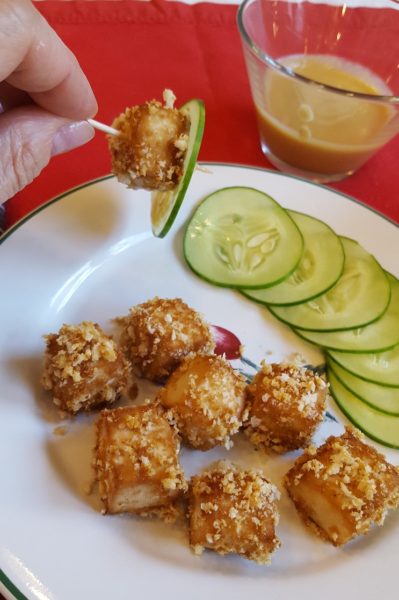 According to the Centers for Disease Control, about one-third of American adults have high blood pressure, which contributes to heart attack, stroke and kidney disease, and about one thousand deaths every day.
According to the Centers for Disease Control, about one-third of American adults have high blood pressure, which contributes to heart attack, stroke and kidney disease, and about one thousand deaths every day.
Those are scary statistics. But a plant-based diet has been shown to lower blood pressure significantly. An impressive number of studies, dating back to the early 1920s, show that the lowest blood pressures are achieved by those eating strictly plant-based diets.
An important component of a plant-based diet is soy, in the form of edamame (young soybeans), soy milk, tofu, and tempeh. We love our soy!
Soy is a nutrient-dense food and excellent source of protein. The soybean contains all of the essential amino acids, as well as an impressive list of vitamins and minerals: calcium, iron, magnesium, manganese, phosphorus, potassium, B vitamins, C and zinc. Fiber, omega-3 and six fatty acids are also present in soy.
Soy Fake News
Despite the powerful health benefits of whole soy foods, myths and misinformation regarding the “dangers” of soy consumption are widely circulated and presented as fact. Let’s take a closer look. (My sources are articles on NutritionFacts.org, where solid peer-reviewed nutrition research is compiled.)
Untruth #1. “Soy is genetically modified (GMO) and since the safety of GMO foods is hotly debated, soy should be avoided.”
Reality: Over 80% of soybeans are GMO, but those are fed to animals, not humans. Soy products for you and me are clearly labeled non-GMO. And glyphosate, or Roundup? Animal feed is drenched in it, and glyphosate residues end up in animal meat. Another reason to avoid meat.
Untruth #2. “Soy causes cancer.”
Reality: This myth stems from confusion around phytoestrogen, a term for plant compounds that are structurally similar to mammal estrogen. Soy-based foods contain phytoestrogens (specifically, isoflavones) in varying amounts.
But isoflavones do not feed tumor growth like estrogen does. In fact, isoflavones have demonstrated a protective benefit against hormone-dependent cancers of the breast, ovaries, and prostate. Eating soy not only reduces the risk of those cancers, it also is recommended for survivors as it lowers the risk of recurrence and reduces mortality.
Soy Lessons from Asia
For centuries, soy has been a staple in Asian cultures. There, the incidence of hypertension, stroke, hormone-dependent cancers, osteoporosis, diabetes, and heart disease are all significantly lower than is seen in the US.
One of the populations with long healthy lives was the Okinawans, who competed with Seventh Day Adventists for longevity. The diet of this Japanese island people was 96% plants, largely purple sweet potatoes, and they consumed more soy than any other Asian country. I’m using “was”—the past tense—because after the Western diet made its way to Okinawa two generations ago, the prevalence of fast food like McDonald’s and Kentucky Fried Chicken has caused a climb in mortality rates.
Soy in a Plant-Based Diet
Here’s how to incorporate soy into your plant-based diet.
- Unsweetened soy milk is sold from the milk coolers at the grocery store. It’s what I put in my coffee and on my oatmeal. Another plus: unlike cow’s milk, plant milks don’t spoil quickly.
- Miso, made from soybeans fermented with grains like rice or wheat, has a great umami flavor. Add a spoonful to soups, salad dressings, sauces.
- Tempeh, made from cooked and slightly fermented soybeans, has a firm texture and nutty flavor. You can buy marinated, sliced tempeh at the grocery store that browns up like bacon.
- Edamame, young green soybeans, are delicious by themselves or as an addition to salad, stir-fry, or soups. Find them in the frozen food section of the grocery store. Children love “mommy” beans, which have a mild taste and slightly nutty texture.
- Tofu is made from cooked soybeans than have been coagulated (like cheese) into curds and pressed into a block. It has very little flavor or aroma of its own. Consequently, tofu can be used in both savory or sweet dishes. It is often marinated in soy sauce, chilies, sesame oil, etc. It is prepared in many ways, including raw, stewed, stir-fried, in soup, cooked in sauce, or stuffed with fillings.
